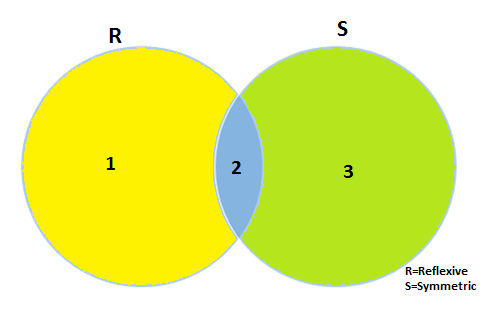Let's Take a Example
A={1,2,3}
A $\times$ A ={ (1,1)(2,2)(3,3)(1,2)(2,1)(1,3)(3,1)(2,3)(3,2) }
Reflexive Relation :- A relation R on a set A is said to be Reflexive if (xRx)∀x∈A
$\underbrace{(1,1)(2,2)(3,3) }_{n}$$\underbrace{(1,2)(2,1)(1,3)(3,1)(2,3)(3,2) }_{n^{2}-n}$
Now For Reflexive relation there are only one choices for diagonal elements (1,1)(2,2)(3,3)
and For remaining n2-n elements there are 2 choices for each.Either it can include in relation or it can't include in relation.
Total number of reflexive relation = $1*2^{n^{2}-n} =2^{n^{2}-n}$
Symmetric Relation:- A relation 'R' on set A is said to be symmetric if (xRy) then (yRx) ∀x,y∈A
$\underbrace{(1,1)(2,2)(3,3) }_{n}$$\underbrace{(1,2)(2,1)(1,3)(3,1)(2,3)(3,2) }_{n^{2}-n}$
For n diagonal elements (1,1)(2,2)(3,3) there are 2 choices for each.Either it can include in relation or it can't include in relation.
For remaining n2-n elements according to definition of symmetric relation we can form pairs of(1,2)(2,1) and (1,3)(3,1)and (2,3)(3,2).For each pair there are 2 choices.Either it can include in relation or it can't not include in relation.
Hence,Total Number of Symmetric Relation= 2n*$2^{\frac{(n^{2}-n)}{2}}$=$2^{\frac{n(n+1)}{2}}$

Now For Reflexive and Symmetric relation there are only one choices for diagonal elements (1,1)(2,2)(3,3) and
for remaining.we can form pairs of(1,2)(2,1) and (1,3)(3,1)and (2,3)(3,2).For each pair there are 2 choices.Either it can include in relation or it can't not include in relation.
Hence,Total Number of Reflexive and Symmetric Relation = $2^{\frac{(n^{2}-n)}{2}}$=$2^{\frac{n(n-1)}{2}}$
n(R)=$2^{n^{2}-n}$
n(S)=$2^{\frac{n(n+1)}{2}}$
n(R∩S)=$2^{\frac{n(n-1)}{2}}$
Total number of relation which is Reflexive or Symmetric n(R∪S)= n(R) +n(S)-n(R∩S)
= $2^{\frac{n(n+1)}{2}}+2^{n^{2}-n}-2^{\frac{n(n-1)}{2}}$